THE COOKBOOK TEST #0063: OUCHI SUSHI
INSTALLMENT #0063 (PAID) A JAPANESE BOOKSTORE WONDERLAND / JAMES VS. SUSHI / RICE! / 'RAPESEED EGGS' / JOYFUL POCKETS / A STRANGE PARFAIT
Dear Subscribers,
This week is a bit of a curveball. During a recent trip to New York City, my friend Kathy brought me to Kinokuniya, a three-story bookstore / cultural mecca for all things Japanese. Manga! Anime! Literature in translation! Stationary! Toys! It's an amazing spot, and while I spent 90 minutes and $200 there, I could have just as easily spent four hours and $1,000. There’s always next time.
I felt inspired to pick up some cookbooks, and choosing just two out of the twenty or thirty that called to me was absolutely agonizing. I wound up going with Your Home Izakaya by Tim Anderson (the author of Japaneasy Bowls and Bento, which I truly enjoyed) and a completely-in-Japanese book called OUCHI SUSHI that was stuffed with professional photography and suggested about a dozen totally refreshing ideas about sushi. Heck, I thought, even without reading a word, the photos alone will suggest some methods that I can build recipes around.
A bit of digging revealed that the book was written by a chef named Yasuyuki Nomoto of Matsu Sushi, which is located in the Yanaka district of Tokyo. (You may know of Yanaka because of its famous shitamachi atmosphere! Or perhaps you don't. I certainly didn't.) As for "Ouchi," I'm reasonably sure that it's a transliteration of "uchi," or home/family, making the title something like "Sushi at Home" or “Homestyle Sushi.” (Actual Japanese speakers: Please feel free to roast me for messing this up!)
So with that backstory out of the way, I got into it, flipping through the gorgeous and enticingly confusing tome. "Man," I thought, "this was a pretty cool idea but there are a lot of nagging questions that the text could help me finesse before I spend $60 at the fish store and utterly mess up my kitchen." [2]
I stared at the book, feeling exactly none of the kanji I once memorized for my college Japanese course float back to the top of my mind. "If only... if only there were an app that could translate text," I thought, sadly. "But of course such a thing can't possibly exist."
But then again: Could it?
Well, duh, of course it does. I grabbed the first one I could find ("Photo Translator"), aimed it at the book’s rice recipe, and fired away.
Kablammo. The same image, but with text in English.
Good. God.
Like: I'm aware that translation stuff has improved over the years, but pulling a computer out of my pocket, aiming it at a field of Japanese characters, and getting a legible result in the form of an altered image was absolutely mind-blowing for me. 12-year-old me would plotz if he saw this. This was a god-like amount of power. Not "The" God, the guy with the beard and lightning bolts, but certainly a god, maybe one of those nerdy dudes like Thoth or Baldur.
But after three images, the app quit on me and demanded money. Hang on... $24 for a year-long license, auto-renewed, or $35 for lifetime use?! What do you take me for, some sort of utter sap made of nothing but U.S. currency? I could buy at least two copies of Balatro for that kind of cash! What if Balatro II and Balatro III come out later this year? My budget would be exhausted!
I put the phone down, and fumed at the unfairness of the universe. And then it occurred to me: having imperfect-but-godlike translation powers in my pocket was honestly not a terrible thing to spend money on. I have spent on $35 on reasonably forgettable entrees at middlebrow restaurants. I have spent $35 on miscellaneous fees attached to supposedly free health checkups. This was doable. So: I did it.
The process is not entirely perfect, of course. While trying to crack the code on a recipe for sushi parfait (see below), I encountered an ingredient called "rapeseed eggs." Was this a badly translated roe of some sort? A fish egg substitute made from, well, rapeseed, which must surely rank amongst nature's worst-named commodities?
A quick Google revealed... nothing whatsoever. Then I remembered that rapeseed is also known as canola. Perhaps... scrambled eggs cooked in oil? A look at the picture and the book's own scrambled egg recipe revealed that this was, in fact, the key.
So as I make my way through a few different recipes here, keep in mind that any errors are as likely to be mine as the book's. Let's see what we can dig up, though.
at your service,
Jim
OUCHI SUSHI
BY YASUYUKI NOMOTO
SEKAI BUNKA HOLDINGS CO., LTD. | 2019 | $22 / Y1300
I have a long and storied relationship with sushi, mostly revolving around me liking to eat it, and me preparing it poorly. The story begins at West High School in Madison, Wisc., where I took an introductory Japanese class. It was in this class that I met the same Kathy who introduced me to Kinokuniya, and where Kathy and I made sushi (assisted greatly by her mom, if memory serves) as a class project. First hard lesson of sushi preparation: Even vegetarian sushi suffers somewhat from being refrigerated overnight. [1] Such were the challenges of preparing sushi for a high school class taking place the next day, of course.
I still credit our class trip to the Yaohan Mall in Chicago and the mind-melting properties of tasting sushi for the first time with unlocking my soul to the enchanting power of new foods - if you want to read about that in lots of detail, the whole story is online.
And then I began making sushi at home. I was bad at it. I remain bad at it. Making proper sushi is like writing a successful novel: you're shooting for a very distant horizon. It took me a couple years to figure out that more than anything else, I was making rice, and that seasoning the rice correctly means carefully metering out the dressing and fanning it to speed the grains' absorption of the liquid. And I had to figure out that trimming fish for nigiri (or even maki) was a matter not just of sawing away, but of first creating a regularly shaped block that could be hewn with precision. (And you can use the scraps for homestyle chirashi!)
And I figured out that potato starch could be used as a great quick cheat for tempura when frying shrimp. And, and, and ... I've learned a dozen lessons about sushi, but the stuff I make still looks pretty bad. It now tastes pretty good! But... it looks pretty bad.
All of this needless suffering means, however, that when I go to a place like Kado no Mise and have a Tokyo-born professional chef prepare sushi for me piece by piece, I'm incredibly impressed. Balance, elegance, grace, the illusion of simplicity concealing thousands of hours of training and practice - that's the good stuff.
Anyhow, let's proceed to the part where a dumbass from Wisconsin fumbles around in a small kitchen.
THE RICE IS THE THING
The recipe for sushi rice in Ouchi Sushi is nearly identical to the one I've been using at home for years with one major exception: rather than heating vinegar in a saucepan to dissolve sugar and salt into it, Ouchi Sushi calls for merely whisking the sugar and salt into the vinegar in a bowl. The recipe says that this helps maintain the flavor of the vinegar, and now that I've tried both methods, I agree - this makes for a more brightly flavored and delicious sushi rice. I won't be heating my sushi rice dressing in the future.
SUSHI RICE
2 cups of sushi rice (volume is before cooking; cooked volume will be more like 5-6 cups)
1/4 sheet kombu (dried seaweed)
1/4 sushi vinegar or rice wine vinegar
1 1/2 Tbsp sugar
1 1/2 tsp salt
Whisk vinegar with sugar and salt in a small bowl to combine.
Cook rice in rice cooker with kombu on top.
When rice is cooked, spread it out in a pan or tray and pour about half the vinegar over the rice.
Use a paddle or wooden spoon to combine rice and dressing, using a fan to cool and incorporate the liquid. Add more vinegar as desired for texture and flavor, but do not over-dress - make sure the rice takes all the moisture.
Cover rice with a tightly wrung out wet cloth to keep from drying out as you make sushi.
Sushi rice tastes best when warm, so if possible don't let it cool down before serving.
RAPESEED EGGS
SCRAMBLED EGGS
Right, this is a recipe for scrambled eggs. Two things I'll say for this recipe, which I'll probably use again for this sort of a Japanese cookery application: the eggs are pretty sweet (which I liked in the savory parfait recipe below), and they actually cook up quite delicately thanks to the final step of letting them finish cooking in a pan with the heat turned off. Whether stirring them with four chopsticks made any difference I'll probably never know, but I certainly enjoyed the novelty of the experience.
OUCHI SCRAMBLED EGGS
3 eggs
1 Tbsp sugar
1/2 tsp light soy sauce
Salt to taste
Vegetable oil
Crack eggs into a bowl and beat them without creating bubbles
Add sugar, soy sauce, and salt and mix well
Heat oil in frying pan over low heat and wipe it evenly with paper towel. You're ready when a little egg drizzled from a chopstick sizzles in a clean line.
Pour in egg mixture and spread it evenly around the pan
Using four chopsticks, stir thoroughly along the bottom of the pan
When mixture is half cooked, turn off heat, mix thoroughly, and let residual heat finish the eggs
POCKET FULL OF TOFU
I'm a big fan of inari (double fried tofu that makes a great wrapper, sandwich exterior, or topping unto itself), and this recipe uses inari as a base for a sushi rice-based savory snack that is somewhat like onigiri in terms of its comfort level and flavor profile.
Once you've sourced your inari and can get your sushi rice reliably prepared, I think you could top these things with whatever you want - raw fish, scrambled eggs, blanched chopped asparagus, diced cooked mushrooms, the sky's the limit. But I enjoyed both of these preparations, particularly the corn, mayo, Parmesan and pepper variety which packed a ton of savory punch.
CUP INARI
1 cup sushi rice
8-10 cup-shaped pieces of boiled fried tofu (I found mind in my Asian grocer's freezer aisle; they defrosted in a jiffy)
1/4 cup of edamame, cooked
Sprinkle of shredded dried tuna to top
1/4 cup of cooked corn kernels mixed with 1 tsp Japanese mayo (Kewpie is a popular brand)
Parmesan cheese to top
Fresh ground pepper to top
Arrange all of your ingredients in little cups or bowls so that they're easy to get to when the rice is done. Stuff your inari pockets with rice near to the top. (I trimmed mine down with scissors so that they had more of a nigiri-sized profile, but whatever works, works.)
Top half of your inari pockets with corn kernels finished with a light sprinkling of Parmesan and a bit of fresh pepper.
Top the other half of the pockets with edamame and a light spinkle of shredded dried tuna.
ROE, ROE, ROE YOUR… PARFAIT
I enjoyed this "parfait" of savory seafood, salmon roe, and rice, and would love to make it again when I can get my hands on edible flowers (all I was able to grab this time around was some purple shiso, which sort of fit the bill but didn't really pack the visual punch I wanted.) My only complaint was that the individual elements - the tuna, the shrimp, particularly the roe - were pretty punchy and it was hard to get a bite that really gave you that “best of all worlds” kind of combination.
So here's my advice on these things: err on the side of less. Less roe, finer chop on the sushi, smaller shrimp (or maybe chop the shrimp rather than garnish with them), and so forth.
SHRIMP AND ROE PARFAIT
1 cup sushi rice
120g raw sushi-grade tuna
Salt to taste
1 Tbsp olive oil
4 shrimp, deveined, peeled, and boiled in water with salt, lemon juice from half a lemon, and 8-10 peppercorns
100g salmon roe
6 Tbsp scrambled eggs
Sprinkle of shredded dried tuna
Thinly sliced cucumber as needed
Edible flowers, shiso, or other visual flourish
Cut tuna into small bite sized pieces, sprinkle with salt, and let sit for 10 minutes. Then add olive oil and mix.
Place scrambled eggs at base of cup, followed by sushi rice, salmon roe, and a bit more rice. Top with a bit of shredded dried tuna and raw tuna, then arrange visual flourish and cucumber slices atop parfait.
OUCHI SUSHI
(***BUY IT*** / ***BORROW IT*** / SKIP IT / SCRAP IT)
Listen: I love this book, and I’m going to treasure it. But buying a written-in-Japanese book is not a great choice for most American home cooks, translation apps notwithstanding. Still, if you get the opportunity, flip through it and goggle at the pictures - there’s a lot of great sushi out there that we don’t get to taste in our American restaurants, even the really good / experimental / playful ones.
[1] WRITER'S NOTE: And by "somewhat," I mean A LOT.
[2] WRITER’S NOTE: I spent like $72 at the fish store. You don’t save a ton of money by making sushi at home, at least not when you’re playing with new recipes.


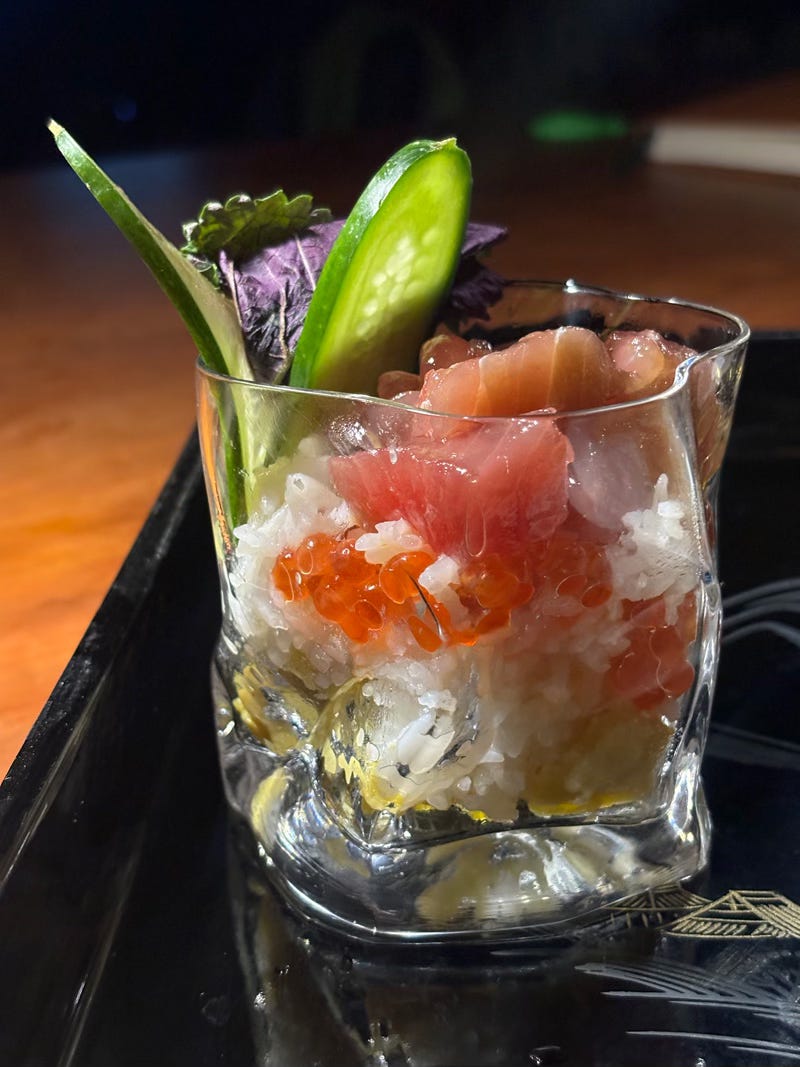
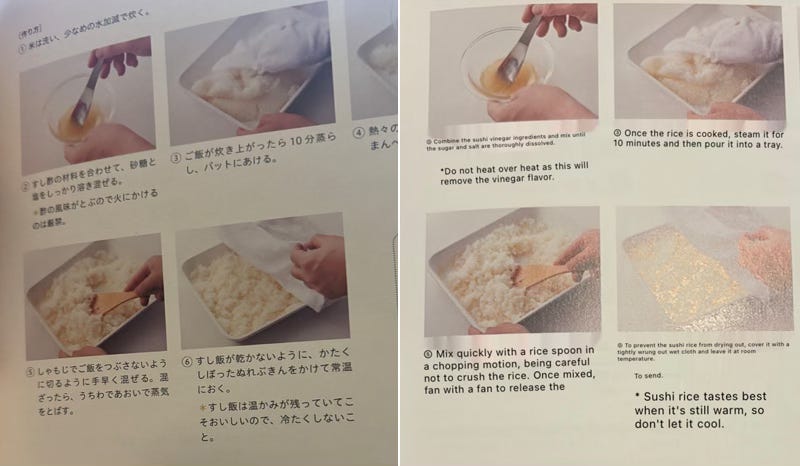
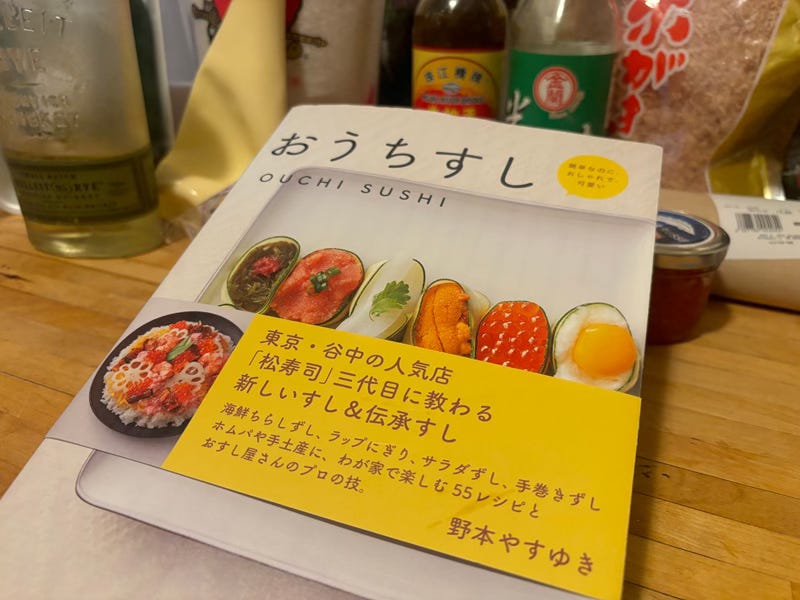

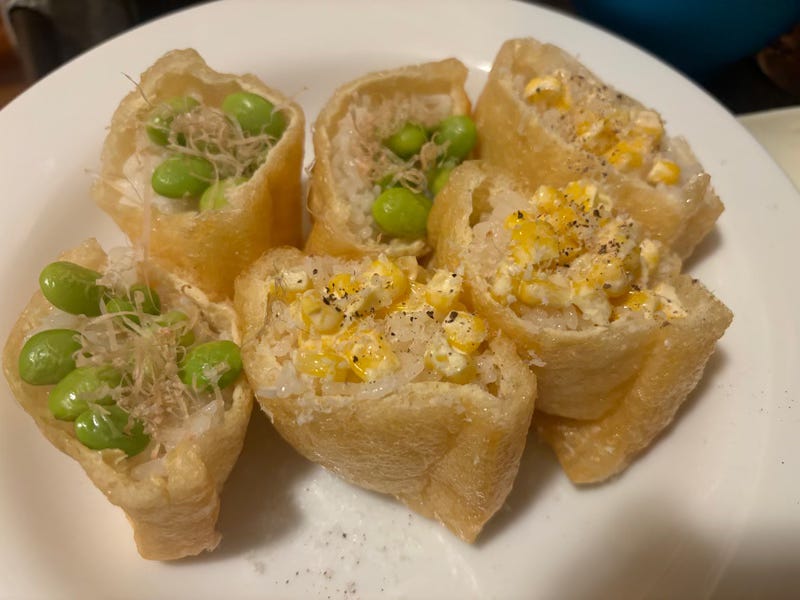
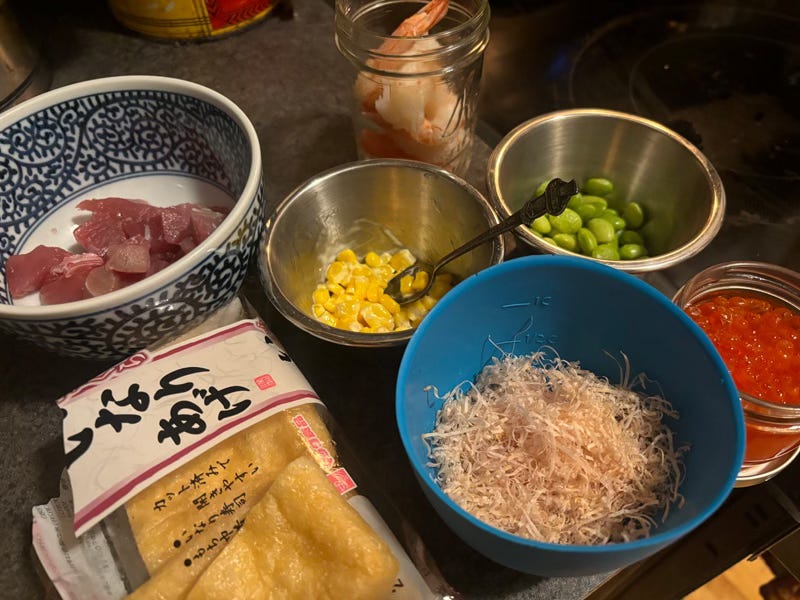

Parfait looks amazing! So glad you enjoyed Kinokuniya.